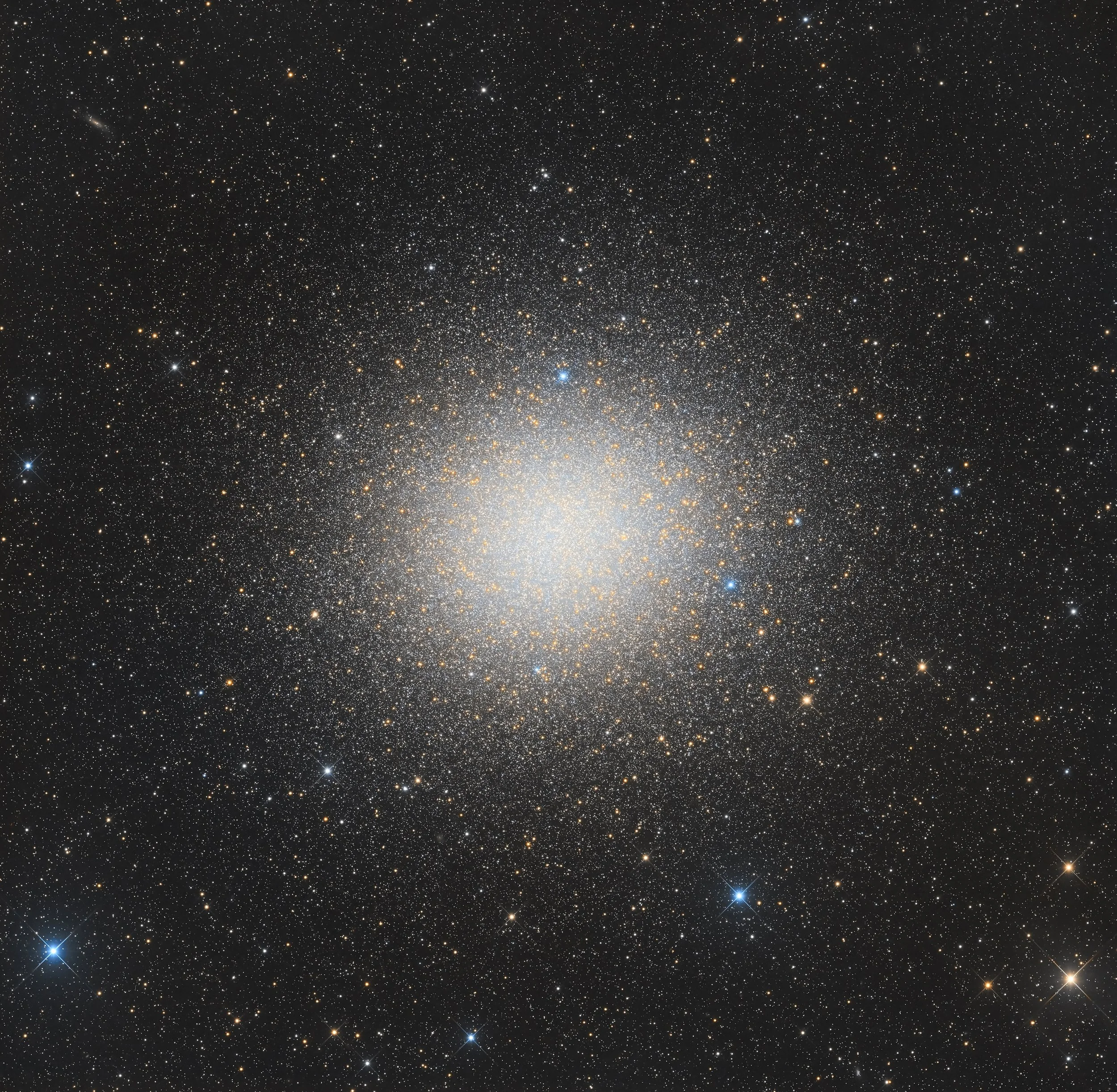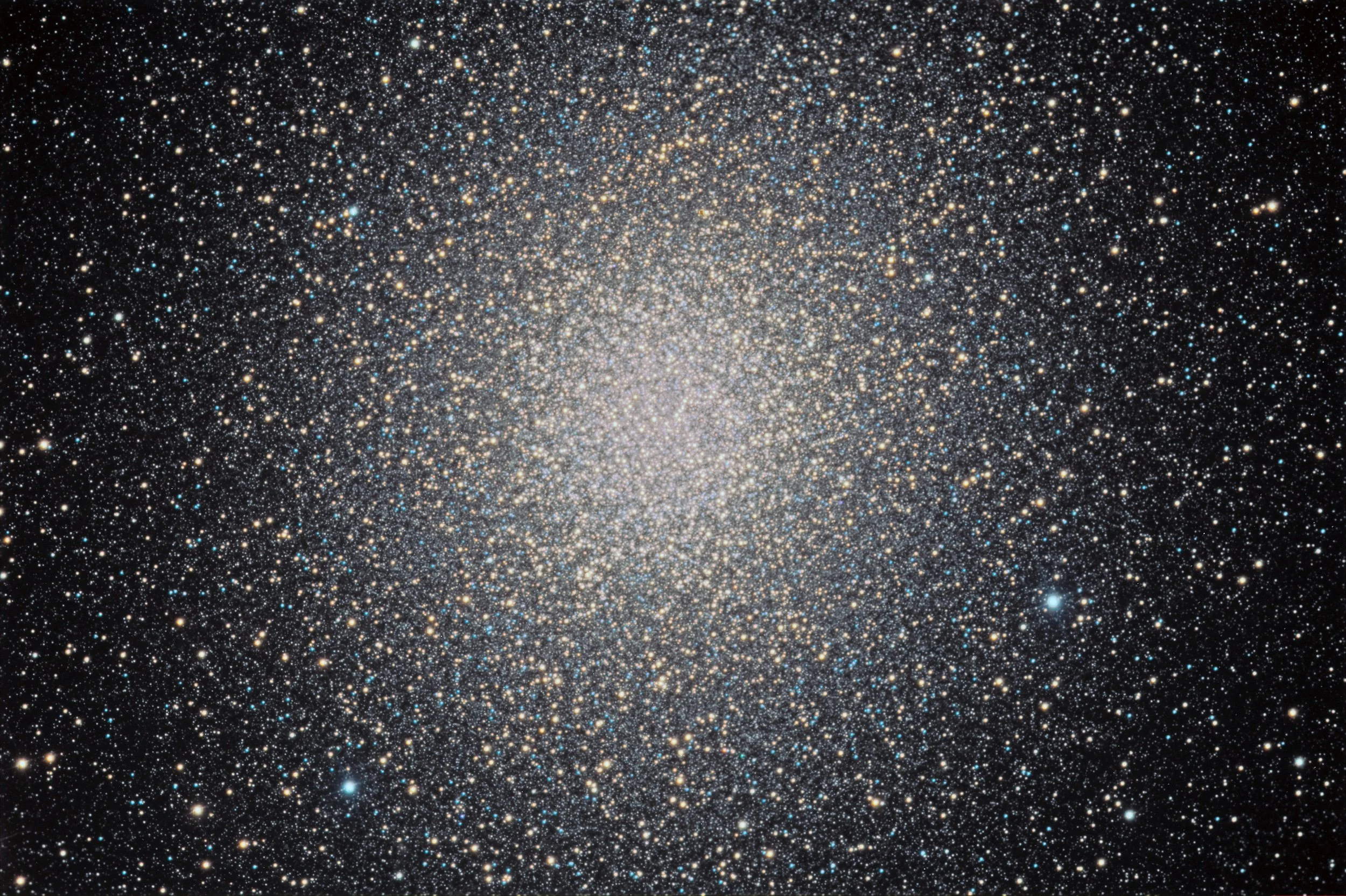
AAPOD2 Image Archives
Sort 2025 By Month: January | February | March | April | May | June | July | August | September | October | November | December
NGC 5139 - Omega Centauri
NGC 5139, commonly known as Omega Centauri, is the largest and brightest globular cluster in the Milky Way. Located in the constellation Centaurus, Omega Centauri is about 15,800 light-years away from Earth and contains several million stars, making it one of the most massive and dense globular clusters known. This cluster spans over 150 light-years in diameter, and its stars range in age from 10 to 12 billion years, offering a glimpse into the early history of our galaxy.
Omega Centauri stands out not only for its sheer size but also for its complex stellar population. Unlike most globular clusters, which typically host stars of a similar age and composition, Omega Centauri contains multiple generations of stars. This suggests that it may have once been the core of a dwarf galaxy that was absorbed by the Milky Way. The cluster's dense core, where stars are packed closely together, contrasts with its more sparsely populated outer regions, creating a stunning visual display in astro images.
Omega Centauri
Omega Centauri, also known as NGC 5139, stands as one of the most magnificent globular clusters in the night sky. Located in the constellation of Centaurus, this stellar ensemble is a sight to behold, boasting millions of stars densely packed together in a spherical formation. With its dazzling brilliance and intricate structure, Omega Centauri captivates observers and astronomers alike, offering a window into the ancient history of our galaxy.
As one of the largest and most massive globular clusters in the Milky Way, Omega Centauri holds valuable clues about the formation and evolution of galaxies. Its dense core, known as a stellar nucleus, harbors a multitude of stars in close proximity, while its outer regions extend across vast distances, spanning tens of thousands of light-years. With its diverse population of stars, including red giants, blue stragglers, and variable stars, Omega Centauri presents a treasure trove of astronomical phenomena waiting to be explored. Studying this remarkable globular cluster provides insights into the dynamics of stellar populations, the gravitational interactions within galactic systems, and the processes that shape the cosmic landscape. As it graces the southern skies with its splendor, Omega Centauri serves as a beacon of inspiration and discovery, inviting observers to marvel at the wonders of the universe.
Omega Centauri Widefield
Omega Centauri, the jewel of the southern skies, commands attention with its brilliant display of millions of stars packed in a gravitational embrace. As the brightest and most massive globular cluster in our Milky Way, Omega Centauri unfolds its celestial grandeur against the backdrop of the galactic halo.
Intertwined with this stellar masterpiece are the Integrated Flux Nebulae, delicate filaments of interstellar dust and gas that subtly reflect the combined light of distant stars. These faint nebular structures, often challenging to observe, add a layer of complexity and depth to the cosmic tableau surrounding Omega Centauri.
Captured in this image is the dynamic dance of light and shadow, where the brilliance of Omega Centauri's stellar ensemble harmonizes with the soft luminosity of the Integrated Flux Nebulae. The interstellar filaments, gently illuminated by the collective glow of background stars, unveil a celestial ballet that speaks to the intricate connections between cosmic elements.
Omega Centauri
Image Description and Details : Taken with my 36.8 cm F9 Ritchey Chretien and STXL6303 CCD camera from my backyard observatory in Canberra Australia. This is a standard LRGB image with luminance = red = green = blue = 50 minutes. Processing in MaximDL, Pixinsight and Adobe photoshop CC
Copyright: Steve Crouch
Omega Centauri
Image Description and Details :
This is an image of Omega Centauri. . It is the largest globular cluster in the Milky Way and is located about 16,000 light years away in the constellation Centaurus. It is estimated to contain approximately 10 million stars and is about 150 light years in diameter.
Telescope: Planewave CDK-24
Camera: FLI PL 9000
Mount: Mathis MI-1000/1250
Red: 4x10 minutes (binned 1x1)
Green: 4x10 minutes (binned 1x1)
Blue: 4x10 minutes (binned 1x1)
Copyright: Bernard Miller
Omega Centauri
Omega Centauri (ω Cen) or NGC 5139 is a globular cluster discovered in 1677 by Edmund Halley, which orbits around the Milky Way, being one of the few that can be observed with the naked eye. It is 17,000 years from Earth, and contains about 10 million stars, which gives it a density such that the average distance between them is 0.1 light years. The stars that comprise it belong mainly to population II, which means that they are very aged.
Copyright : Aniceto Porcel Rosales







